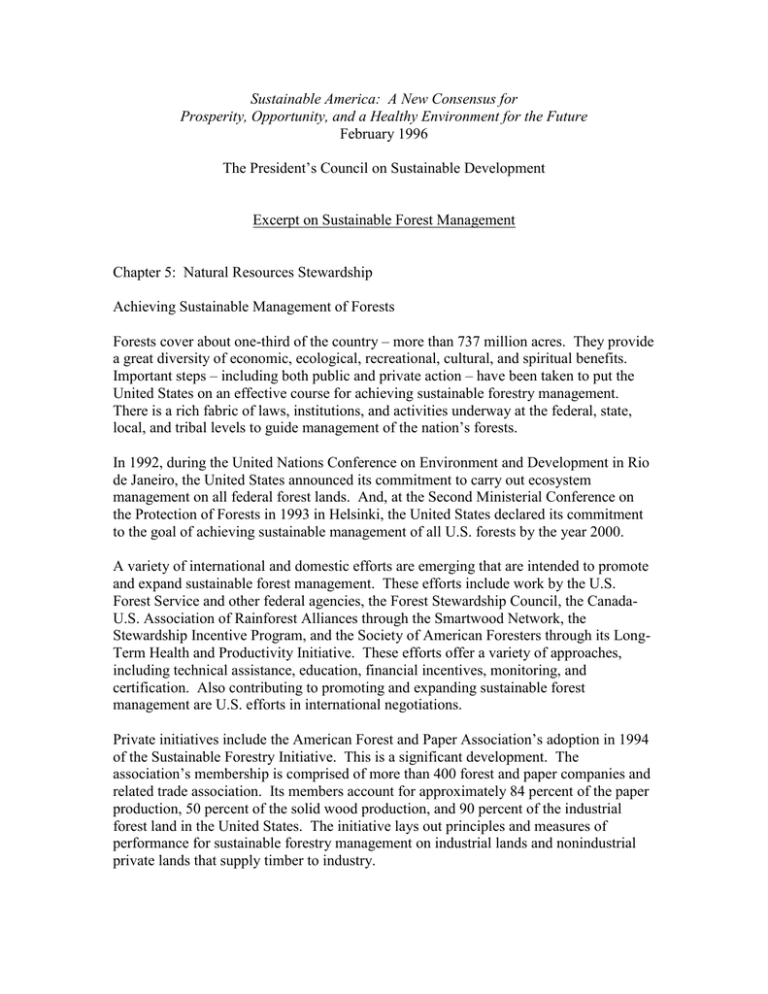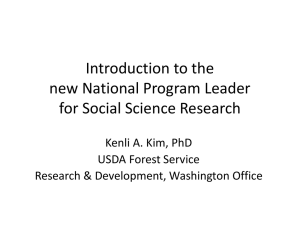Sustainable America: A New Consensus for
advertisement

Sustainable America: A New Consensus for Prosperity, Opportunity, and a Healthy Environment for the Future February 1996 The President’s Council on Sustainable Development Excerpt on Sustainable Forest Management Chapter 5: Natural Resources Stewardship Achieving Sustainable Management of Forests Forests cover about one-third of the country – more than 737 million acres. They provide a great diversity of economic, ecological, recreational, cultural, and spiritual benefits. Important steps – including both public and private action – have been taken to put the United States on an effective course for achieving sustainable forestry management. There is a rich fabric of laws, institutions, and activities underway at the federal, state, local, and tribal levels to guide management of the nation’s forests. In 1992, during the United Nations Conference on Environment and Development in Rio de Janeiro, the United States announced its commitment to carry out ecosystem management on all federal forest lands. And, at the Second Ministerial Conference on the Protection of Forests in 1993 in Helsinki, the United States declared its commitment to the goal of achieving sustainable management of all U.S. forests by the year 2000. A variety of international and domestic efforts are emerging that are intended to promote and expand sustainable forest management. These efforts include work by the U.S. Forest Service and other federal agencies, the Forest Stewardship Council, the CanadaU.S. Association of Rainforest Alliances through the Smartwood Network, the Stewardship Incentive Program, and the Society of American Foresters through its LongTerm Health and Productivity Initiative. These efforts offer a variety of approaches, including technical assistance, education, financial incentives, monitoring, and certification. Also contributing to promoting and expanding sustainable forest management are U.S. efforts in international negotiations. Private initiatives include the American Forest and Paper Association’s adoption in 1994 of the Sustainable Forestry Initiative. This is a significant development. The association’s membership is comprised of more than 400 forest and paper companies and related trade association. Its members account for approximately 84 percent of the paper production, 50 percent of the solid wood production, and 90 percent of the industrial forest land in the United States. The initiative lays out principles and measures of performance for sustainable forestry management on industrial lands and nonindustrial private lands that supply timber to industry. One of the key events in forestry is the Seventh American Forest Congress scheduled for February 1996 in Washington, D.C. It is being convened by a broad range of participants – including environmental, industry, government, and academic leaders – to develop a shared vision; set of principles; and recommendations for forest policy, research, and sustainable management of America’s forests into the next century. Forest congresses have been held periodically since 1882 to provide a forum for rethinking the role of forests. The last one took place in 1975. The President’s Council on Sustainable Development views the Seventh American Forest Congress as an opportunity to forge a nonpartisan, dynamic, and participatory course for the future. The Council’s policy recommendation is intended to build on this and other initiatives already under way for sustainable management and protection of the nation’s public and private forests. Policy Recommendation 5 Achievement of Year 2000 Sustainable Forest Management Goal: Establish a structured process involving a representative group of stakeholders to facilitate public and private efforts to define and achieve the national goal of sustainable management of forests by the year 2000. Action 1. The President should direct USDA, the U.S. Department of the Interior, and other relevant agencies to build upon, support, and promote ongoing efforts to achieve sustainable forest management. These efforts should address such areas as national and international initiatives, terms of reference, criteria for defining sustainable forest management and indicators to measure progress toward their achievement, and use of resulting information in policy formulation. The agencies should explore various means for accomplishing this; the Seventh American Forest Congress offers one important avenue.



